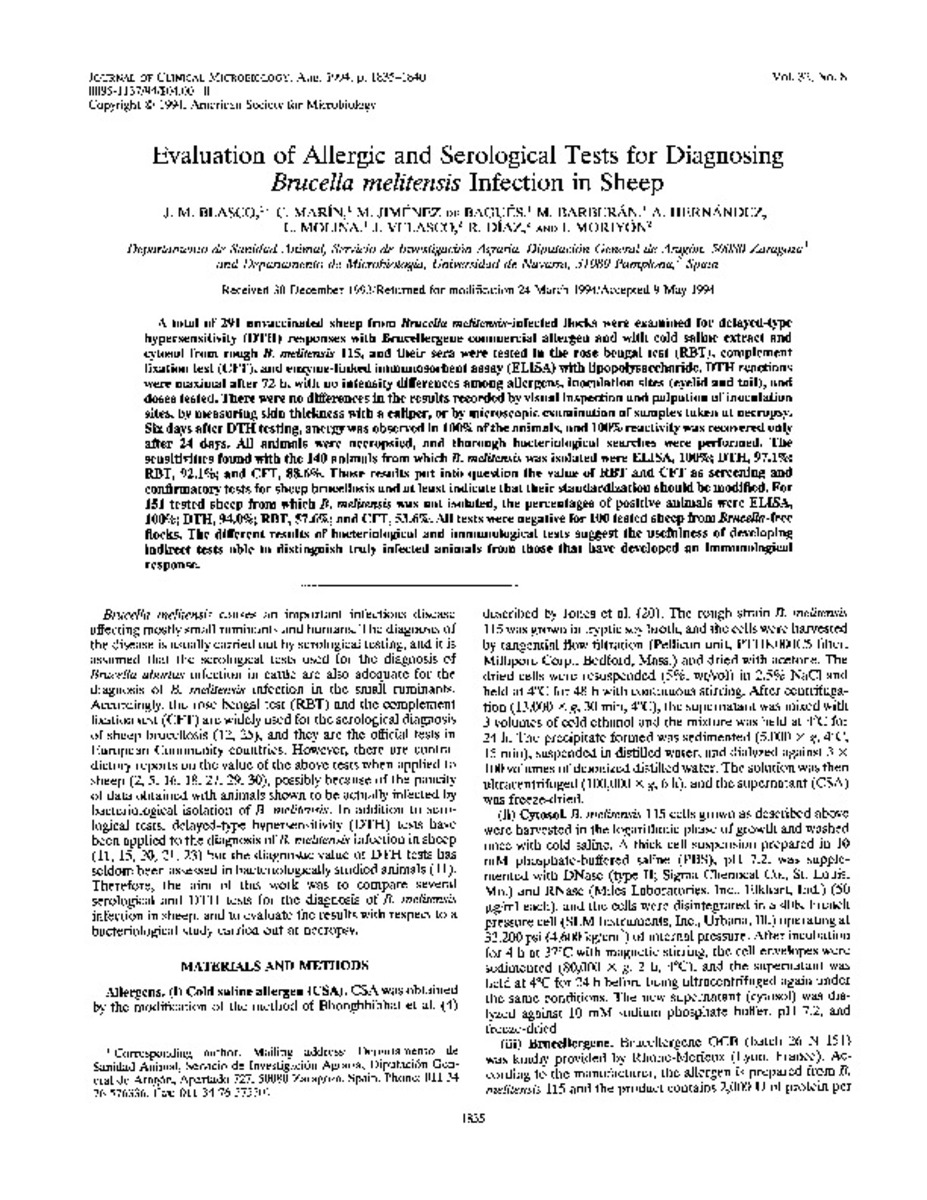Full metadata record
| DC Field | Value | Language |
|---|---|---|
| dc.creator | Blasco, J.M. (J. M.) | - |
| dc.creator | Marin, C.M. (C. M.) | - |
| dc.creator | Jimenez-de-Bagues, M. (M.) | - |
| dc.creator | Barberan, M. (Montserrat) | - |
| dc.creator | Hernandez, A. (A.) | - |
| dc.creator | Molina, L. (L.) | - |
| dc.creator | Velasco, J. (Julián) | - |
| dc.creator | Diaz, R. (Ramón) | - |
| dc.creator | Moriyon, I. (Ignacio) | - |
| dc.date.accessioned | 2013-06-25T12:35:50Z | - |
| dc.date.available | 2013-06-25T12:35:50Z | - |
| dc.date.issued | 1994 | - |
| dc.identifier.citation | Blasco JM, Marin C, Jimenez de Bagues M, Barberan M, Hernandez A, Molina L, et al. Evaluation of allergic and serological tests for diagnosing Brucella melitensis infection in sheep. J Clin Microbiol 1994 Aug;32(8):1835-1840. | es_ES |
| dc.identifier.issn | 0095-1137 | - |
| dc.identifier.uri | https://hdl.handle.net/10171/29432 | - |
| dc.description.abstract | A total of 291 unvaccinated sheep from Brucella melitensis-infected flocks were examined for delayed-type hypersensitivity (DTH) responses with Brucellergene commercial allergen and with cold saline extract and cytosol from rough B. melitensis 115, and their sera were tested in the rose bengal test (RBT), complement fixation test (CFT), and enzyme-linked immunosorbent assay (ELISA) with lipopolysaccharide. DTH reactions were maximal after 72 h, with no intensity differences among allergens, inoculation sites (eyelid and tail), and doses tested. There were no differences in the results recorded by visual inspection and palpation of inoculation sites, by measuring skin thickness with a caliper, or by microscopic examination of samples taken at necropsy; Six days after DTH testing, anergy was observed in 100% of the animals, and 100% reactivity was recovered only after 24 days. All animals were necropsied, and thorough bacteriological searches were performed. The sensitivities found with the 140 animals from which B. melitensis was isolated were ELISA, 100%; DTH, 97.1%; RBT, 92.1%; and CFT, 88.6%. Those results put into question the value of RBT and CFT as screening and confirmatory tests for sheep brucellosis and at least indicate that their standardization should be modified. For 151 tested sheep from which B. melitensis was not isolated, the percentages of positive animals were ELISA, 100%; DTH, 94.0%; RBT, 57.6%; and CFT, 53.6%. All tests were negative for 100 tested sheep from Brucella-free flocks. The different results of bacteriological and immunological tests suggest the usefulness of developing indirect tests able to distinguish truly infected animals from those that have developed an immunological response. | es_ES |
| dc.language.iso | eng | es_ES |
| dc.publisher | American Society for Microbiology | es_ES |
| dc.rights | info:eu-repo/semantics/openAccess | es_ES |
| dc.subject | Polyacrylamide gels | es_ES |
| dc.subject | Silver stain | es_ES |
| dc.subject | Proteins | es_ES |
| dc.title | Evaluation of allergic and serological tests for diagnosing Brucella melitensis infection in sheep | es_ES |
| dc.type | info:eu-repo/semantics/article | es_ES |
| dc.type.driver | info:eu-repo/semantics/article | es_ES |
Files in This Item:
Statistics and impact
Items in Dadun are protected by copyright, with all rights reserved, unless otherwise indicated.






